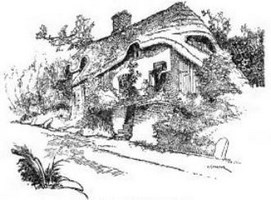Cottage on Rye Hill in Bere Regis (1904), by Charles George Harper
Published as part of his book, 'The Hardy Country - literary Landmarks of the Wessex Novels'
Here then is the introduction to the “Kingsbere-sub-Greenhill” of the Wessex novels, the “half-dead townlet . . . the spot of all spots in the world which could be considered the D’Urbervilles’ home, since they had resided there for full five hundred years.”
This “blinking little place,” and now perhaps a not even blinking, but fast asleep village, was at one time a market-town, and, more than that, as its latinised name would imply, a royal residence. Kingsbere, said to mean “Kingsbury”—that is to say, “King’s place” or building—really obtained its name in very different fashion.
It was plain “Bere,” long before the Saxon monarchs came to this spot and caused the latter-day confusion among antiquaries of the British “bere,” meaning an underwood, a scrub, copse, bramble, or thorn-bed, with the Anglo-Saxon “byrig.” We have but to look upon the surroundings of Bere Regis even at this day, a thousand years later, to see how truly descriptive that British name really was.
It was of old a place greatly favoured by royalty, from that remote age when Elfrida murdered her stepson, Edward the King and Martyr, at Corfe Castle, and thrashed her own son Ethelred here with a large wax candle, for reproaching her with the deed.
Those events happened in A.D. 978, and it is therefore not in any way surprising that no traces of the ferocious Queen Elfrida’s residence have survived.
Ethelred, we are told, hated wax candles ever after that severe thrashing, and doubtless hated Bere as well; but it was more than ever a royal resort in the later times of King John, who visited it on several occasions in the course of his troubled reign. Thenceforward, however, the favours of monarchs ceased, and it came to depend upon the good will of the Abbots of Tarent Abbey and that of the Turbervilles, who between them became owners of the manor.
The village street of Bere is bleak and barren. It is a street of rustic cottages of battered red brick, or a compost of mud, chopped straw, and lime, called “cob,” built on a brick base, often plastered, almost all of them thatched: some with new thatch, some with thatch middle-aged, others yet with thatch ancient and decaying, forming a rich and fertile bed for weeds and ox-eyed daisies and “bloody warriors,” as the local Dorsetshire name is for the rich red wall-flowers.
Sometimes the old thatch has been stripped before the new was placed: more often it has not, and the merest casual observer can, as he passes, easily become a critic of the thoroughness or otherwise with which the thatcher’s work has been performed, not only by sight of the different shades belonging to old and new, but by the varying thicknesses with which the roofs are seen to be covered. Here an upstairs window looks out immediately, open-eyed, upon the sunlight; there another peers blinkingly forth, as behind beetling eyebrows, from half a yard’s depth of straw and reed, shading off from a coal-black substratum to a coffee-coloured layer, and thence to the amber top-coating of the latest addition.
Warm in winter, cool in summer, is the testimony of cottagers towards thatch; and earwiggy always, thinks the stranger under such roofs, as he observes quaint lepidoptera ensconced comfortably in his bed.
Picturesque it certainly is, expensive too, although it may not generally be thought so; but it is more enduring than cheap slates or tiles, and, according to many who should know, if indeed their prejudices do not warp their statements, cheaper in the long run.


